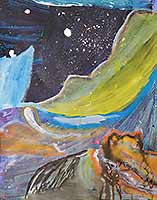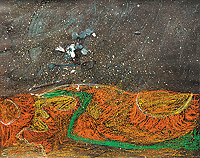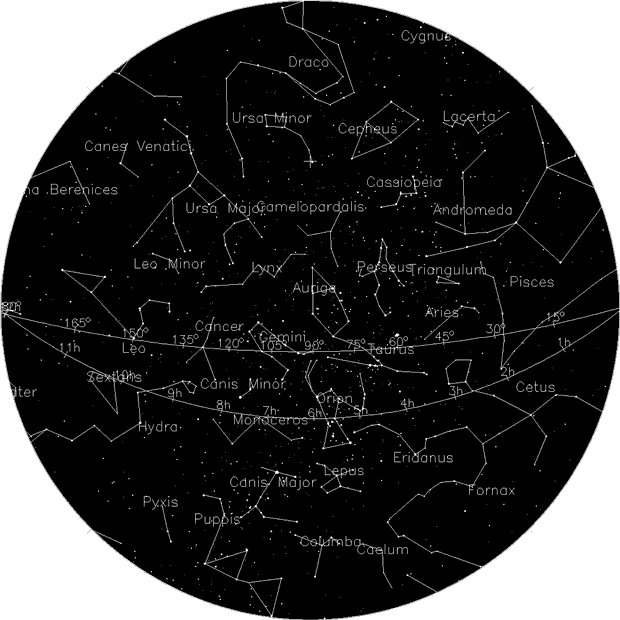DARK SKY HAPPENINGS - February 2018
Moab
UT (at City Hall)
38°34’ N Latitude 109°33’ W Longitude
4048 ft - 1234 m |
Getting Kids Excited about
Moab’s Dark Night Skies
By Darcey Brown
Sunrise-Sunset
for February
(The time of sunrise
and sunset assumes
a flat horizon.
Actual time may
vary depending upon the landscape.) |
DATE |
SUNRISE |
SUNSET |
1 |
7:24am |
5:40pm |
2 |
7:23am |
5:42pm |
3 |
7:22am |
5:43pm |
4 |
7:21am |
5:44pm |
5 |
7:20am |
5:45pm |
6 |
7:19m |
5:46pm |
7 |
7:18am |
5:47pm |
8 |
7:17am |
5:48pm |
9 |
7:16am |
5:50pm |
10 |
7:15am |
5:51pm |
11 |
7:13am |
5:54pm |
12 |
7:12am |
5:53pm |
13 |
7:11am |
5:54pm |
14 |
7:10am |
5:55pm |
15 |
7:09am |
5:56pm |
16 |
7:08am |
5:57pm |
17 |
7:06am |
5:59pm |
18 |
7:05am |
6:00pm |
19 |
7:04am |
6:01pm |
20 |
7:03am |
6:02pm |
21 |
7:01am |
6:03pm |
22 |
7:00am |
6:04pm |
23 |
6:59am |
6:05pm |
24 |
6:57am |
6:06pm |
25 |
6:56am |
6:07pm |
26 |
6:54am |
6:08pm |
27 |
6:53am |
6:09pm |
28 |
6:52am |
6:10pm |
|
 One of the best ways to achieve our Mission of promoting the appreciation and conservation of Moab’s unique and rare dark skies is to get kids to think about and enjoy the spender of our night sky. In 2017, we got to engage with kids in some pretty fun ways. Not only did kids from the Moab Multi-Cultural Center get the chance to see Venus in the crescent phase, they also had the benefit of learning about the celestial sights they got to see through a telescope from Dead Horse Point State Park’s Night Sky Ranger, Crystal White. Last fall, all Moab area third and fourth graders got the chance to think about and paint the night sky. One of the best ways to achieve our Mission of promoting the appreciation and conservation of Moab’s unique and rare dark skies is to get kids to think about and enjoy the spender of our night sky. In 2017, we got to engage with kids in some pretty fun ways. Not only did kids from the Moab Multi-Cultural Center get the chance to see Venus in the crescent phase, they also had the benefit of learning about the celestial sights they got to see through a telescope from Dead Horse Point State Park’s Night Sky Ranger, Crystal White. Last fall, all Moab area third and fourth graders got the chance to think about and paint the night sky. Art Coach Bruce Hucko got kids excited about the history of night sky art by showing them famous night sky paintings, and awe-inspiring night sky photography. In getting them engaged, Art Coach got the kids to share stories about family and friends who have visited Moab and been taken aback by the awesomeness of the area’s dark night skies. Sufficiently excited about night time art, and revved up about the incredibleness of our night sky, he set them to work with paper, paintbrush, and toothbrush (to get that so-important stippled star effect) to impressive effect. Art Coach Bruce Hucko got kids excited about the history of night sky art by showing them famous night sky paintings, and awe-inspiring night sky photography. In getting them engaged, Art Coach got the kids to share stories about family and friends who have visited Moab and been taken aback by the awesomeness of the area’s dark night skies. Sufficiently excited about night time art, and revved up about the incredibleness of our night sky, he set them to work with paper, paintbrush, and toothbrush (to get that so-important stippled star effect) to impressive effect.
It’s easy for kids to get excited about our night skies. It holds stories, lessons, mysteries, beauty, surprises, and some local pride too. The Moab Dark Skies group is so inspired by the enthusiasm kids have for learning about the night sky. We can’t wait to feed their appetite for knowledge about the night sky this year and hopefully help  foster some young astronomers. If given a chance sometime this month, take your kids outside at night and show them the Big Dipper, Orion, the Milky Way, and the Man in the Moon. I’d bet you could expect to hear a few “oohs and aah’s” or maybe a “that’s so cool”! For some more advanced night sky viewing try a night sky app such as “Sky View” or “Planets” or some a good kid friendly night sky book such as The Stars by H.A. Rey or A Child’s Introduction to the Night Sky by Michael Driscoll. foster some young astronomers. If given a chance sometime this month, take your kids outside at night and show them the Big Dipper, Orion, the Milky Way, and the Man in the Moon. I’d bet you could expect to hear a few “oohs and aah’s” or maybe a “that’s so cool”! For some more advanced night sky viewing try a night sky app such as “Sky View” or “Planets” or some a good kid friendly night sky book such as The Stars by H.A. Rey or A Child’s Introduction to the Night Sky by Michael Driscoll.
Moab Dark Skies mission is to promote the appreciation and conservation of Moab’s valuable and rare dark skies. The Moab Dark Skies was established by the Friends of Arches and Canyonlands Parks in conjunction with the National Park Service and Utah
State Parks Division of Natural Resources. |
VISIBLE PLANETS
Morning (At Twilight)
Mars – Rising in the eastern sky around 2:30am.
Jupiter – Rising around midnight to 1pm.
Saturn – Rises around 5:00 am early in the month and at 3:30 am towards Feb. 28th.
February Constellations
Notable constellations for the month are Gemini and Canis Major. Gemini is known as “The Twins” and is home to one of the most famous pairs of stars in the night sky--Castor and Pollux. Gemini is also home to a Galactic Cluster known as M35 which contains about 200 stars and can easily be seen with a pair of binoculars. Canis Major or “Big Dog” is the companion constellation to Orion and is the bigger of his two hunting dogs. Canis Major is home to Sirius, also known as the “Dog Star”, and is the brightest star in the winter night sky.
Moon Happenings
There are no full moons in February. January 31st was a full moon and total lunar eclipse. (The moon rises later each day—as little as 30 minutes to as much as one hour. Time of moonrise and moonset may also be delayed in mountainous terrain.)
February 7 – Dark evening skies return; waning last quarter moon rises at 12:40 am.
February 15 – New moon yielding dark skies for several nights.
February 23 – Waxing first quarter lights the evening sky then sets at 1:13 am.
Hold the star chart high above your head and match the compass directions to the direction you are facing. Adjust the star chart by orienting Ursa Major (Big Dipper) to match its position in the sky and pull the edges down to create a dome.
The star chart approximates the sky from astronomical twilight to midnight. As the night and month progresses, the constellations shift toward the northwest. The celestial equator is measured in hours (h).
The ecliptic is measured in degrees.
|
 One of the best ways to achieve our Mission of promoting the appreciation and conservation of Moab’s unique and rare dark skies is to get kids to think about and enjoy the spender of our night sky. In 2017, we got to engage with kids in some pretty fun ways. Not only did kids from the Moab Multi-Cultural Center get the chance to see Venus in the crescent phase, they also had the benefit of learning about the celestial sights they got to see through a telescope from Dead Horse Point State Park’s Night Sky Ranger, Crystal White. Last fall, all Moab area third and fourth graders got the chance to think about and paint the night sky.
One of the best ways to achieve our Mission of promoting the appreciation and conservation of Moab’s unique and rare dark skies is to get kids to think about and enjoy the spender of our night sky. In 2017, we got to engage with kids in some pretty fun ways. Not only did kids from the Moab Multi-Cultural Center get the chance to see Venus in the crescent phase, they also had the benefit of learning about the celestial sights they got to see through a telescope from Dead Horse Point State Park’s Night Sky Ranger, Crystal White. Last fall, all Moab area third and fourth graders got the chance to think about and paint the night sky. Art Coach Bruce Hucko got kids excited about the history of night sky art by showing them famous night sky paintings, and awe-inspiring night sky photography. In getting them engaged, Art Coach got the kids to share stories about family and friends who have visited Moab and been taken aback by the awesomeness of the area’s dark night skies. Sufficiently excited about night time art, and revved up about the incredibleness of our night sky, he set them to work with paper, paintbrush, and toothbrush (to get that so-important stippled star effect) to impressive effect.
Art Coach Bruce Hucko got kids excited about the history of night sky art by showing them famous night sky paintings, and awe-inspiring night sky photography. In getting them engaged, Art Coach got the kids to share stories about family and friends who have visited Moab and been taken aback by the awesomeness of the area’s dark night skies. Sufficiently excited about night time art, and revved up about the incredibleness of our night sky, he set them to work with paper, paintbrush, and toothbrush (to get that so-important stippled star effect) to impressive effect.  foster some young astronomers. If given a chance sometime this month, take your kids outside at night and show them the Big Dipper, Orion, the Milky Way, and the Man in the Moon. I’d bet you could expect to hear a few “oohs and aah’s” or maybe a “that’s so cool”! For some more advanced night sky viewing try a night sky app such as “Sky View” or “Planets” or some a good kid friendly night sky book such as The Stars by H.A. Rey or A Child’s Introduction to the Night Sky by Michael Driscoll.
foster some young astronomers. If given a chance sometime this month, take your kids outside at night and show them the Big Dipper, Orion, the Milky Way, and the Man in the Moon. I’d bet you could expect to hear a few “oohs and aah’s” or maybe a “that’s so cool”! For some more advanced night sky viewing try a night sky app such as “Sky View” or “Planets” or some a good kid friendly night sky book such as The Stars by H.A. Rey or A Child’s Introduction to the Night Sky by Michael Driscoll. 